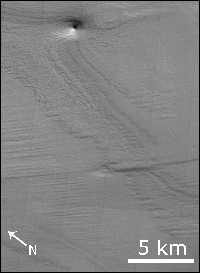
MARS | Science

South polar layered deposits on Mars sculpted by directional winds (left to
right) into ridge-and-groove topography known as Australe Sulci. The resistant
buttes may be pedestal crater remnants. (Mosaic of parts of Mars Odyssey THEMIS
visual range images V08829007 and V0854014; image credit: NASA/JPL/Arizona
State University).
Full Resolution Version: 600 KB
Order high-quality reprints
Full Resolution Version: 600 KB
Order high-quality reprints
Accumulation and erosion of south polar layered deposits in the Promethei Lingula region,Planum Australe, Mars
1Eric J. Kolb and 2Kenneth L. Tanaka
1Dept. of Geological Sciences, Arizona State University, Tempe, AZ 85287, USA
2Astrogeology Team, U.S. Geological Survey, Flagstaff, AZ 86001, USA
Mars 2, 1-9, 2006 | doi:10.1555/mars.2006.0001
Received December 4, 2005 | Accepted March 31, 2006 | Published April 15, 2006
The geologic mapping of south polar layered deposits in the Promethei Lingula region, Planum Australe, Mars, indicates that aeolian-based South Polar Layered Deposit accumulation and erosion were controlled by substrate topography, leading to formation of large canyon systems. Subsequent erosion is largely confined to the chasmata walls and marginal scarp of Promethei Lingula and no evidence is observed for lateral migration of spiral troughs.
PDF 1.6 MB | ZIP 29.7 MB | TAR.GZ 29.7 MB | Supporting Files